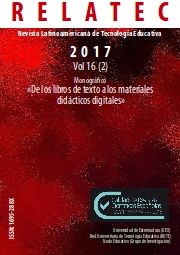Between tradition and innovation: the use of textbooks and didactic digital contents in classrooms
DOI:
https://doi.org/10.17398/1695-288X.16.2.97Keywords:
Textbook, Auto-Production, Didactic Digital Content, Digital Text, Digital Skills, Libro de Texto, Auto-producción, Contenido Didáctico Digital, Texto Digital, Competencias DigitalesAbstract
Since 2013, the Italian Minister of Education promoted the use of digital or mixed paper-digital texts in the classroom by means of legislative act (Lex 128/2013). Since then, adoption of the textbook is not mandatory in our country: Italian schools, according to their autonomy, can choose to adopt teaching materials from publishers, Open Educational Resources, or auto-produced texts. The law legitimates the experience of some Italian schools that are innovating the use of textbooks and are involved in a process of auto-production of content (textbooks or DDC, Didactic Digital Content). The article attempts to describe the work of these schools within a network of practice named «Avanguardie Educative». It intends to analyse teachers beliefs and attitudes upon «studying», «textbooks» and «digital texts», to capture innovative aspects, but also to look at difficulties and obstacles along the path of innovation, not always so clear and well defined.
Downloads
References
Anichini, A., Bucciarelli, I., Chipa, S., Morani, R., Parigi, L., Taddeo, G. et al. (a cura di), (2016) Avanguardie educative. Linee guida per l’implementazione dell’idea «Integrazione CDD/Libri di testo», Indire, Firenze.
Anichini, A. (2014). Digital writing. Nel laboratorio di scrittura. Rimini: Maggioli Editore.
Anichini, A. (2015). Riscritture digitali e libri di testo. Form@ re-Open Journal per la formazione in rete, 15(1), 73-86.
Bennett, B., Spencer, D., Bergmann, J., Cockrum, T., Musallam, R., Sams, A. (2012). The flipped class manifest. The Daily Riff.
Braga Garcia, T. M. (2015). Textbook production from a local, national and international point of view. In Jesus Rodriguez Rodriguez, Mike Horsley, Susanne V. Knudsen, 10th International Conference on Textbooks and Educational Media, IARTEM.
Braga Garcia, T. M., Schmidt, M. A. (2015). The Cultural Experience as a reference to the production of textbooks by teachers and children. In J. Rodriguez Rodriguez, M. Horsley, S. V. Knudsen, 10th International Conference on Textbooks and Educational Media, IARTEM.
Bruillard, E., Villemonteix F. (2011). Les communautés en ligne d’enseignants, nouveaux modes d’organisation et de production. Mercredis de Créteil. Université Paris VIII.
Castiello, C. (2015). Libros de texto y materiales alternativos: La experiencia del grupo Eleuterio Quintanilla. In J. Rodriguez Rodriguez, M. Horsley, S. V. Knudsen, 10th Internationl Conference on Textbooks and Educational Media, IARTEM.
Choppin, A. (1992). Le manuels scolaires : histoire et actualité. Paris: Hachette Éducation.
Choppin, A. (2003). Former les enseignants au choix et à l‟utilisation de leurs manuels: histoire et actualité. In B. Germain, I. Le Guay & R. Nadine (eds.), Le Manuel de lecture au CP: réflexions, analyses et critères de choix (pp. 12-16). Paris: ScéREn, Savoir Livre
Choppin, A. (2008). Le manuel scolaire, une fausse évidence historique. Revue d’histoire de l’éducation, INRP, n° 117, 19 juin 2008.
Cochran-Smith, M., Feiman-Nemser, S., McIntyre, D. J., & Demers, K. E. (Eds.). (2008). Handbook of research on teacher education: Enduring questions in changing contexts. London: Routledge.
Desgagné, S., Bednarz, N., Lebuis, P., Poirier, L., & Couture, C. (2001). L'approche collaborative de recherche en éducation: un rapport nouveau à établir entre recherche et formation. Revue des sciences de l'éducation, 27(1), 33-64.
Dori, Y. J., Belcher, J., Bessette, M., Danziger, M., McKinney, A., & Hult, E. (2003). Technology for active learning. Materials Today, 6(12), 44-49.
Drechsler, M. (2011). Manuels scolaires et albums augmentés: Enjeux et perspectives pour une pédagogie du 21e siècle. Les Éditions Numeriklivres.
Eco, U., Bonazzi, M. (1972). Introduzione a I pampini bugiardi. Indagine sui libri al di sopra di ogni sospetto: I testi delle scuole elementari. Rimini: Guaraldi.
Freinet C., (1964). Plus de manuels scolaires! Plus de leçons! «L’éducateur», November 1964
F. Richaudeau (1979), Conception et production des manuels scolaires. Paris: UNESCO.
Hutchinson, T., Torres, E. (1994). The Textbook as Agent of Change, ELT Journal n. 48/4, 1994, pp. 315-328
Laici, C., & Orlandini, L. (2016). «Avanguardie Educative»: paths of innovation for schools. Research on Education and Media, 8(1), 53-61.
Mayring, P. (2014), Qualitative content analysis: theoretical foundation, basic procedures and software solution. Klagenfurt. URL: http://nbn-resolving.de/urn:nbn:de:0168-ssoar-395173
Moeglin, P. (2010). Les industries éducatives, Que sais-je?, Paris: PUF
Mortari, L. (Ed.). (2010). Dire la pratica: la cultura del fare scuola. Milano: Bruno Mondadori.
O. E. C. D. (2012). Assessment and analytical framework: Mathematics, reading, science, problem solving and financial literacy. 2013-2-21].http://www.oecd.org/pisa/pisaproducts/pisa2012draftframeworks-mathematicsproblemsolvingandfinancialliteracy.htm
Pettini A. et al. (1974), Il libro di testo nella didattica moderna. Firenze: La Nuova Italia.
Rivoltella, P. C. (2013). L'agire didattico: manuale per l'insegnante. Brescia: La Scuola.
Rodriguez Rodriguez, J., Garcia Garcia, I. (2015). The Electaal Elemental Education Project. In J. Rodriguez Rodriguez, M. Horsley, S. V. Knudsen, 10th International Conference on Textbooks and Educational Media, IARTEM.
Roncaglia, G. (2016). Ruolo ed evoluzione dei libri di testo. In C. Reale (eds.). Il libro al centro. Percorsi tra le discipline del libro in onore di Marco Santoro. Napoli: Liguori.
Downloads
Published
Issue
Section
License
Authors who publish in this journal accept the following conditions:
1. The Author retains copyright in the article. Upon acceptance of the article, the author shall grant to the Publisher the right of first publication of the article. with the dcoument registered with the Creative Commons Attribution-NonCommercial-NoDerivative 4.0 International (CC BY-NC-ND) license, which allows to third parties to use what is published whenever they mention the authorship of the work and the first publication in this journal.
2. Authors can make other independent and additional contractual agreements for the non-exclusive distribution of the article published in this journal (eg, include it in an institutional repository or publish it in a book) provided they clearly indicate that the work was published for the first time in this journal.
3. Authors are allowed and recommended to publish their work on the Internet (for example on institutional or personal pages) before and during the review and publication process, as it can lead to productive exchanges and a greater and faster diffusion of published work (see The Effect of Open Access).









